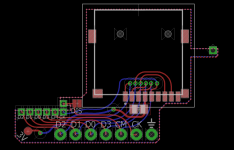Would it not be possible to make the PCB a little shorter to clear U29 entirely? For example (And please forgive my terrible photo editing skills)
<EDIT> If the issue is clearance for inserting/removing the microSD card, would it fit better if the slot was rotated 180degrees? Something closer to the attached mockup, although obviously the traces would need rerouting,
Or alternatively there are 'flip top' micro SD slots which wouldn't require the extra space for insertion/removal.
No, I'm not compromising the integrity of the memory by using an unreliable interconnect. Those "clam-shell' SD card sockets are terribly unreliable. I'm only going to use a spring mechanism, self locking interface as this is designed to install once and never touch again.
It's fine the way that it is, currently. But if you can source a micro SD connector that's both shallow and not a piece of shit, I'll consider it.
There's no point into going to all of this trouble and then use an unreliable, questionable interface for a system that already has memory problems.
Last edited by Voultar,




